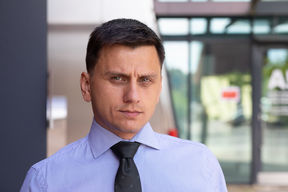Alexandru Paler: Creating software for quantum computers

Alexandru Paler has joined the department of computer science as an assistant professor. Paler was previously a researcher at Johannes Keppler University, Linz in Austria and did his PhD slightly further upstream on the Danube at the University of Passau in Germany. We spoke to him about his work on developing software for quantum computing.
What do you research?
My work is like a triangle, with three sides that support each other. First is the design and implementation of quantum software, the second is quantum error correction software, and the third, newest side, is quantum circuit simulation.
I did my PhD in circuit design, which including quantum circuit design. After this, my research focused on quantum software, which is the software required for operating a quantum computer. It’s such a wide area and there are many people working in different corners, so the work covers a lot of bases. I spent two of my postdoc years writing code, but realized that a lot of it was useless. I’d made state of the art tools, but they did not produce state of the art results because there wasn’t the possibility to actively incorporate error-correction methods. So, I started exploring which software parameters need to be optimized in order to improve the detection of errors.
With quantum computers, errors can arise from imperfections in the hardware and noise from the environment, and these are problems that physicists are trying to solve. But even with a perfect system you would still get errors from the environment, so I am interested in software that can recognize and correct these errors. These tools are called quantum decoders.
The third part of my research is related to quantum circuit simulation. We started looking into simulation software because testing the decoders and analyzing the circuits needs a quantum computer, and we don’t have quantum computers quite yet. Simulating quantum computers is a difficult problem, so we are focusing only on specific simulation requirements.
These three strands make up the triangle of my work, hopefully they will come together and result in something nice.
What interested you about the field?
To be honest I didn’t really have a clue at the time what I was getting myself into. In retrospect, I was drawn to this field because it’s a challenging problem. I didn’t care too much for my employability, I was interested in the research challenges.
So where do you see the field going next?
I'm into the field of quantum computing because it's so interdisciplinary in the truest sense, it's quite difficult to stay afloat of everything that's happening. Even if you cut out all of the hype—of which there is a lot— people are generating very interesting results about computing and engineering in general. We’re learning things that are valuable for fields outside of quantum computing. One example is that I did my Master’s thesis on digital image processing, which had nothing to do with quantum computing. Now, people are talking about quantum machine learning, with applications in things like image classification. It is possible to connect broad research areas of computer science, physics and engineering together with quantum computing research. Even if quantum computing turned out to be a great big disappointment and didn’t work at all, then there would be value from all the sharing of knowledge from across all these different fields!
Contact:
Alexandru Paler
Professor
Department of Computer Science
[email protected]
Read more news

DeployAI Partners Gather for Heart Beat Meeting in Helsinki
The European DeployAI project's partners gathered for the Heart Beat meeting hosted by Aalto University Executive Education in Helsinki.
Aalto computer scientists in ICML 2024
Computer scientists in ICML 2024
In low-hierarchy organisations, even key policy issues are discussed in Slack
In a recent study, Aalto University alumn Lauri Pietinalho, a visiting scholar at New York University's Stern School of Business, and Frank Martela, an assistant professor at Aalto University, investigated how low-hierarchy organisations deal with shared policies in confrontational situations and how authority functions within them.